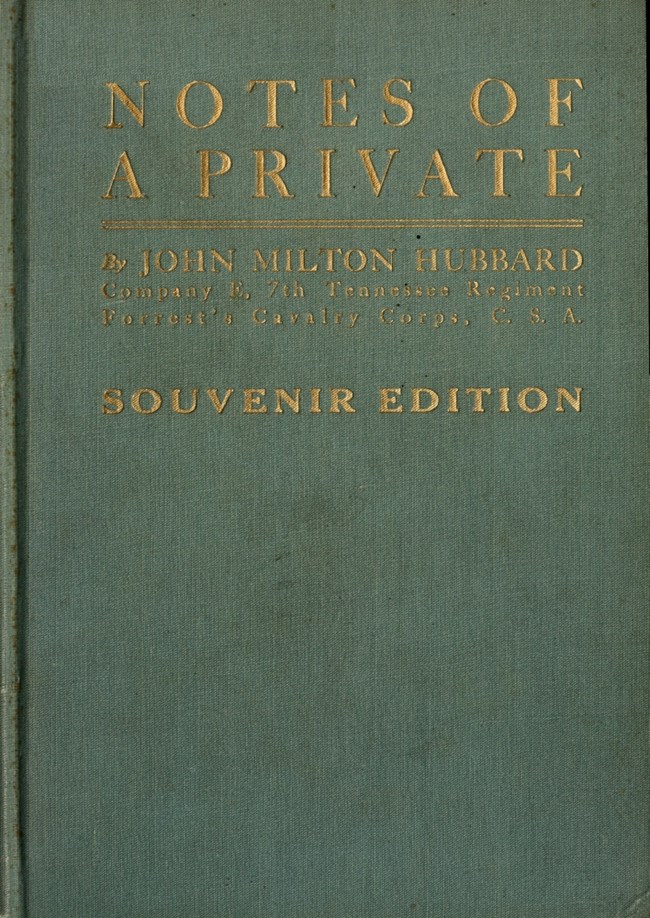
Public Domain John Milton Hubbard was born on January 17, 1833 in Anson County, North Carolina. In the 1840s, Hubbard attended the newly chartered Baylor University in Waco, Texas, where among his classmates was future Confederate General and Texas governor, Sullivan Lawrence Ross. Hubbard studied education as he later listed his occupation as ‘teacher’ during later census counts and he mentions some of his students is his book “Notes of a Private in Forrest’s Cavalry Corps.”
Hubbard joined the Confederate army in May of 1861. He enlisted in the Confederate army with 100 other men from Bolivar, Tennessee part of Hardeman County east of Memphis. His and other unites were combined into the 7th Tennessee Cavalry, CSA in April 1862. He stayed in Company E, 7th Tennessee for the until he was paroled on May 11, 1865 at Gainesville, Alabama.
The 7th Tennessee confronted the Federals in Mississippi, moved with Forrest to West Tennessee and Kentucky, then saw action in East Tennessee. Later the regiment participated in the Battles of Franklin and Nashville, and in 1865 skirmished in Alabama. It contained 696 effectives in July, 1862, had 210 present for duty in October, 1863, but very few surrendered at Gainesville, Alabama, in May, 1865.
During the Battle of Brices Cross Roads on June 10, 1864 Duckworth's 7th Tennessee was briefly placed into a Brigade with the 18th Mississippi Battalion under the command of Colonel E. V. Rucker. On June 10th, Forrest struck a blow to the Sturgis' Federals at Brice's Crossroads, near Baldwyn, Mississippi. As soon as Rucker's Brigade entered the field of battle, they were ordered to dismount and charge the Federal position across a muddy field. As the Brigade charged, they were met with heavy volleys of enemy fire. Initially they were repulsed with heavy losses before reforming and continuing the attack. Under heavy fire, the 7th Tennessee dragged the enemy's defenses out of the way and began pouring in through the exposed gap. Fierce hand-to-hand combat ensued with the Union soldiers. Pistols came into play and rifle butts were used as clubs in some of the most desperate fighting the Regiment would ever encounter. The Federal line finally gave way and retreated. Forrest then attacked with his entire force driving the Federals back to Tishomingo Creek, where their retreat turned into a rout. Forrest's mobility and superior tactics help his force of 3,500 Confederate defeat the vast superior Federal numbers of General Sturgis' 8,500 men.
The Battle of Brice's Crossroads was Forrest's greatest victory of the Civil War. Not only had his force succeeded in routing a much larger Federal force, but Forrest had also captured 16 artillery pieces, 176 wagons and 1,500 stands of small arms. Forrest's casualties numbered 96 men killed and 396 wounded. Casualties on the Union side were much worse, 223 killed, 394 wounded and 1,623 men missing. 
Public Domain "...When riding to the battle-field that morning, and at a place where we were passing over a rough causeway on which many a horse cast a shoe, Isaac H. Pipkin (Doc.), riding by my side, remarked that if he should be killed that day, all he asked was to be put away decently. He was in the first charge, through the muddy cornfield. Imagine my feelings, when driven back in one of the repulses, I came upon his body still in death. Doc was a typical rustic, a good fellow in camp, a true soldier in action, a man you might lean on. The people of Bolivar have long ago graven his name in marble. Tom Boucher was a plain and unassuming citizen of the Whiteville neighborhood, who was always at his post, took life easy and never fretted. He died on the field. In the first charge, I noticed William C. Hardy, of Bolivar, handling his gun as if something was the matter with the lock. I never saw him again, for he never got to the second fence. Billy was a pupil of mine, a fiery young fellow and a perfectly reliable soldier. Another schoolboy of mine who fell in this first charge was Charles R. Neely of Bolivar. He was a boy of gentle birth and noble instincts. He was a loving friend, a soldier tried and true, who poured out his young life’s blood upon the field. Could higher eulogy be spoken? In connection with young Neely’s death I mention the faithful conduct of James F. Dunlap, his mess mate and true friend. As soon as practicable Dunlap placed the corpse of his young friend in their small mess wagon and carrying it through the country delivered it to his mother in Bolivar, Tenn. This was an exhibition of fidelity hard to surpass. Suffering from an old wound, Captain Tate, early in the action turned over the command of the company to Lieutenant J. P. Satler, with whom I had already agreed to remain through whatever might come to us that day. Thank heaven, we both came through unscathed." To read the full version of his book “ Notes from a Private” go to http://www.gutenberg.org/ebooks/49466 where you can download copies in the public domain. |
Last updated: June 7, 2020
